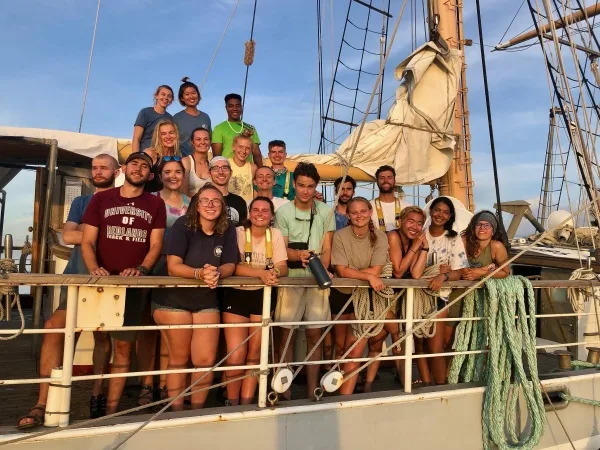Programs Blog
Arrival in Kanton

Mary Zarba, B Watch, SUNY College of Environmental Science and Forestry
Ship’s Log
Noon Position
2° 48.408 ‘S x 171° 42.851 ‘W
Ship Heading
0
Ship Speed
0
Description of location
Kanton, PIPA
It is 1930 (7:30 am) on a Friday night, and I am hanging out on the bow of the Robert C. Seamans. I have come to know this specific location on the boat as the “bow watch spot.” One member of the crew has stood here, tethered to the stay, all the way forward where the sides of the boat come to a point, for every hour that we’ve been underway. In this spot, I have been welcomed by a beautiful pastel sunrise, thrown around by a violent squall, greeted by a pod of pilot whales, and treated to a sky full of more stars than I knew existed. Hila, the B watch officer, has instructed my shipmates and me to always stand for the full hour whenever on bow watch. However, right now I am seated in this spot, the reason being that for the first time in 13 days, we have reached land! The boat now lies very still with the sails furled and dock lines tethering it to the remote atoll of Canton.
 Mary
Mary
Around 1400 (2:00 pm) this afternoon, the Seamans sailed into a narrow passageway leading us out of the open ocean and into the middle of Kanton’s lagoon. The crew worked together in the sweltering heat to secure the boat alongside. Some of our tasks included tying the boat up, setting up the gangway, putting up mosquito nets, and inflating the small boats. Once the boat was secured, I was able to report back to my assigned job for today as assistant steward! Lauren (Cookie), our amazing steward, and I whipped up homemade hummus and cheese spread with veggies and crackers as an appetizer, and later prepared tuna tetrazzini as the main course. As the sun was going down, I received my first taste of Kanton during a quick stroll through the island. Looking down into the small space between the boat and the bulkhead, I saw multiple schools of vibrant blue and yellow fish darting around elaborate corals through the crystal clear water. As I continued down the one sandy pathway I could find on the island, hundreds of vibrant red hermit crabs ducked into their shells while local children ran out of their homes to greet us with big smiles. Just from briefly observing the surface of Kanton, I could see that it was teeming with life. I can’t even begin to imagine what the landscape will look like below the surface in PIPA’s “Underwater Eden”.
Currently, everyone on the ship is hanging out on deck before going to sleep. I can hear “Hey Jude” being strummed on a ukulele with a chorus of people singing along coming from the quarterdeck. Behind me, I can make out the dark outlines of a few people sprawled out on the head rig who are tracing constellations through the sky. In front of me a full, orange moon is rising above the calm water of the lagoon. Everyone will be heading to their bunks shortly in order to get sufficient rest before numerous coral reef snorkeling excursions begin in the morning. Tomorrow, our exploration of PIPA officially begins.
– Mary Zarba, B Watch, SUNY College of Environmental Science and Forestry
Mom – I love you and can’t thank you enough. Tell Peter not to worry, I’ve been wearing my swimmies the whole time. Also make sure my friends aren’t having too much fun without me 🙂
Recent Posts from the Ships
- Ocean Classroom 2024-A collaborative high school program with Proctor Academy
- Collaborations and Long-term Commitments: SEA’s Caribbean Reef Program Sets a Course for Coastal Programs that Compliment Shipboard Experiences.
- Sea Education Association students prepare for life underway using state of the art nautical simulation from Wartsila Corporation.
- SEA Writer 2022, Magazines From the Summer SEA Quest Students
- Technology@SEA: Upgrades Allow Insight into Ocean Depths
Programs
- Gap Year
- Ocean Exploration
- High School
- Science at SEA
- SEA Expedition
- SEAScape
- Pre-College
- Proctor Ocean Classroom
- Protecting the Phoenix Islands
- SPICE
- Stanford@SEA
- Undergraduate
- Climate and Society
- Climate Change and Coastal Resilience
- Coral Reef Conservation
- Marine Biodiversity and Conservation
- MBL
- Ocean Exploration: Plastics
- Ocean Policy: Marine Protected Areas
- Oceans and Climate
- Pacific Reef Expedition
- The Global Ocean: Hawai'i
- The Global Ocean: New Zealand